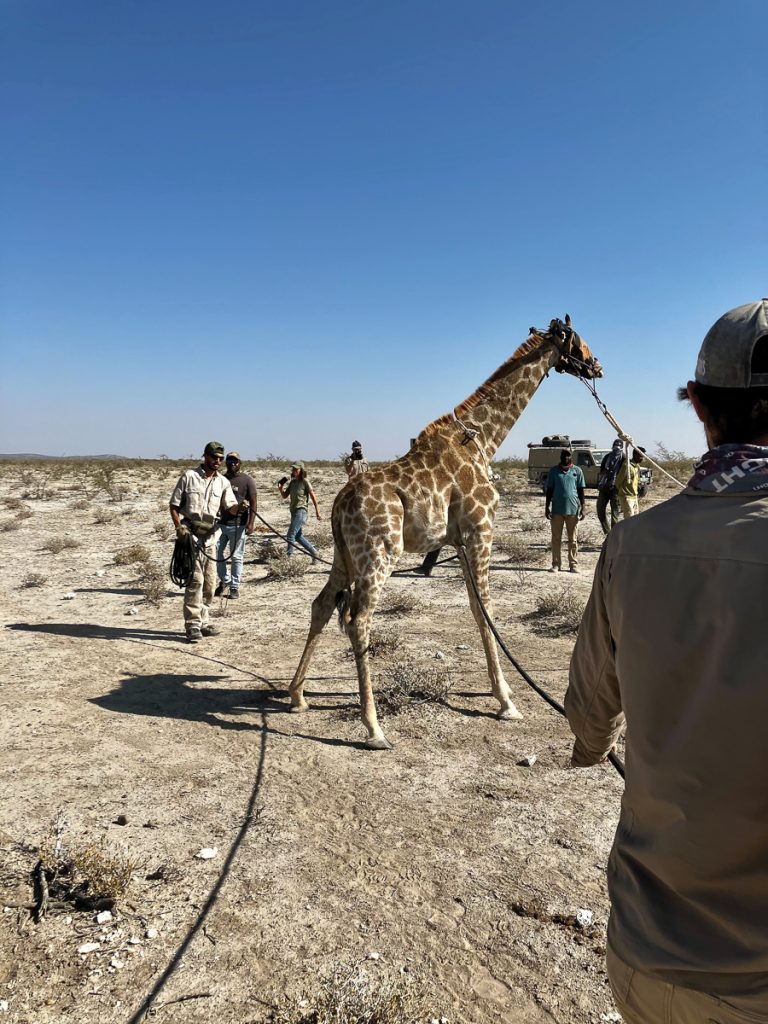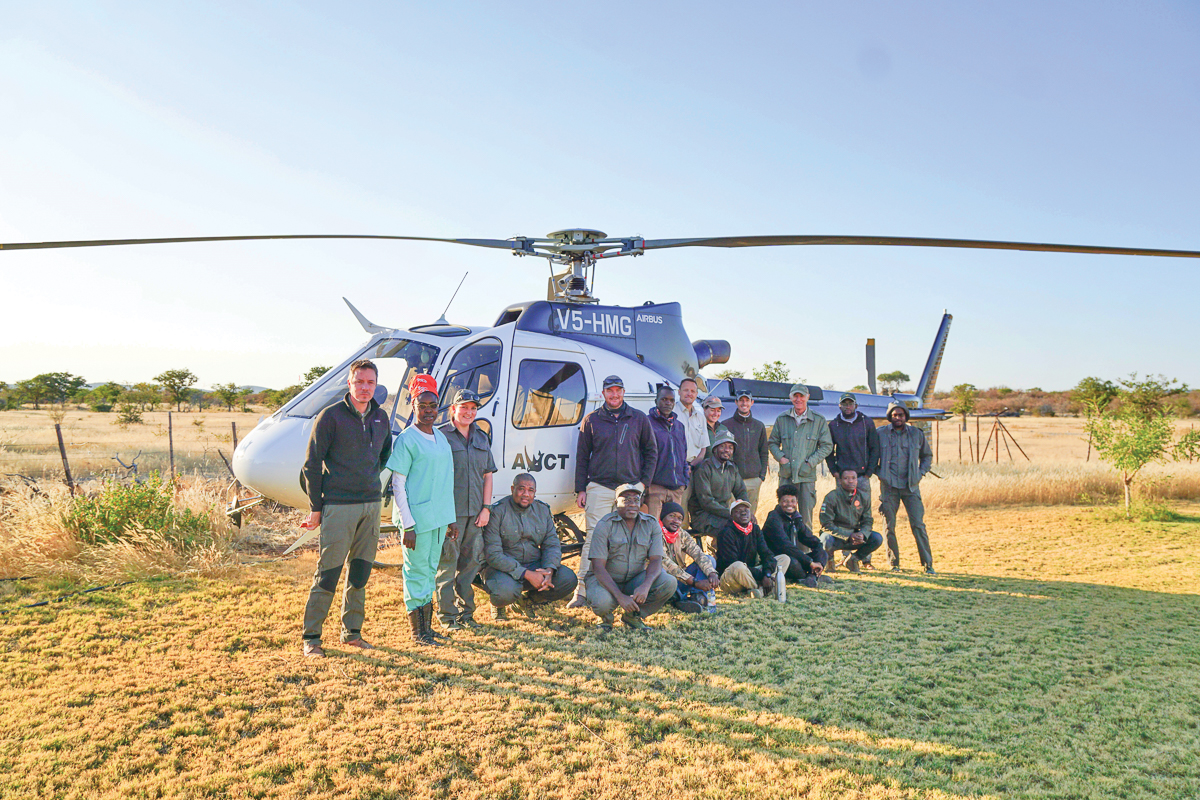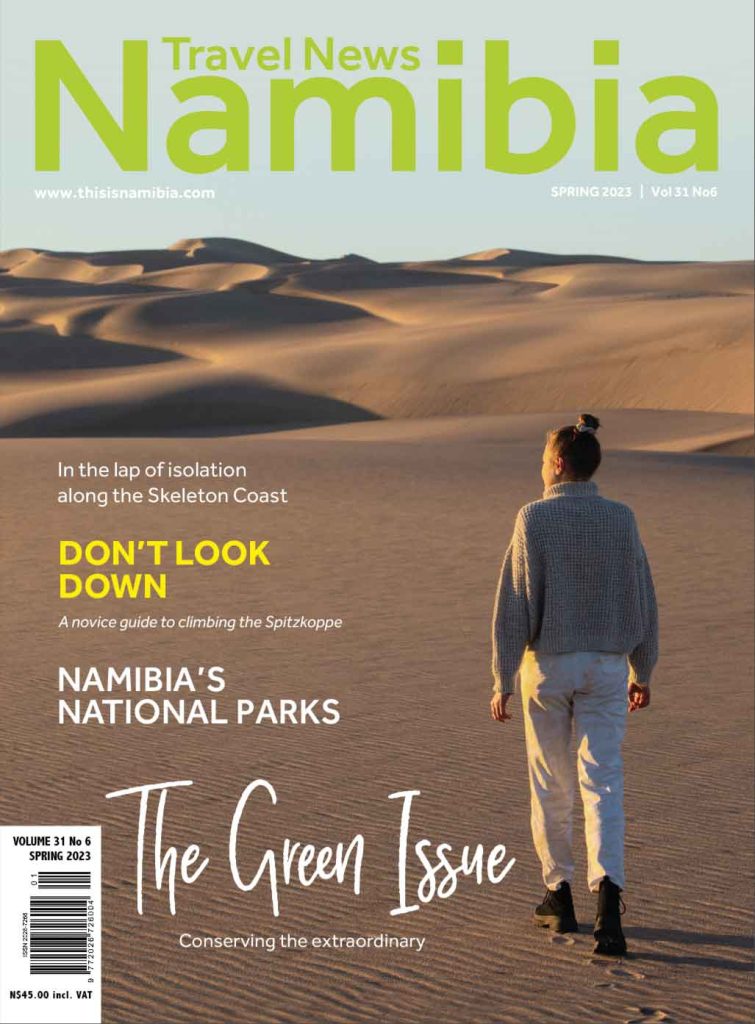

Conservation beyond giraffe
Enhancing capacities and empowering young African wildlife veterinarians.
Text & Photographs Giraffe Conservation Foundation
From the Spring 2023 issue
Being a wildlife veterinarian in Africa is a tough job! You have to be flexible, resourceful and work in often extremely remote areas under challenging conditions. And to make matters worse, training opportunities are very limited, so most wildlife vets end up training on the job. They must understand a vast diversity of species, from the smallest antelope to lions to elephants; and that does not even consider the reptiles and birds that also come into the mix. Then there is the giraffe – darting, immobilising and treating the world’s tallest animal adds an entirely different level of complexity to the task and increases the challenges exponentially. As if that were not enough, African wildlife vets are frequently required to work in remote and isolated settings, often with little experience or training in the safe handling of dangerous drugs, darting and capture equipment or species-specific protocols. It can feel like what one might imagine walking a tightrope without a safety net while juggling knives may feel – daunting.
The limited training opportunities in African wildlife medicine are generally expensive, restricting access for many veterinarians in Africa. Luckily for Namibia, things are looking a little different here. We boast a network of highly experienced wildlife veterinary professionals in our country, as well as the School of Veterinary Medicine at the University of Namibia (UNAM), which offers a solid introduction to wildlife medicine. As a result, Namibia is well placed to support local capacity and build that of wildlife vets from other parts of Africa.
Founded and headquartered in Namibia, the Giraffe Conservation Foundation (GCF) is dedicated to securing a future for all giraffe populations in the wild. It is the global leader in giraffe conservation. GCF started off by monitoring Angolan giraffe in the remote northwest of Namibia in what has become the longest long-term ecological effort of monitoring giraffe in Africa. While giraffe populations in Namibia are doing well, the GCF team quickly realised that the same is not the case in most other parts of the continent. From its humble beginnings in northwestern Namibia, GCF now actively implements and supports giraffe conservation initiatives in 19 African countries, often requiring the services of wildlife veterinarians as part of the conservation team. “Due to their unique physiology, giraffe can be particularly difficult to immobilise”, says Dr Julian Fennessy, GCF’s Co-founder and Director of Conservation. “To ensure their safety, we often bring along vets from Namibia or South Africa when working in other African countries. The problem is not a lack of local vets, but often there is limited expertise in handling giraffe and other wildlife, or simply a lack of confidence. Confidence that can only be developed through practical experience.”
Since this approach is unsustainable for a long-term conservation impact, GCF approached partners in Namibia to take matters into their own hands and develop a training course for African wildlife vets. In 2022, in partnership with UNAM and the Namibia University of Science & Technology (NUST), GCF organised the first dynamic, practical wildlife immobilisation course tailored for young African vets. The second course was successfully conducted in June 2023. Both courses hosted eight aspiring wildlife vets from seven and eight African countries respectively, who were mentored by a similar number of highly experienced wildlife veterinary and conservation experts. Participants experienced a unique training opportunity. They hailed from the Central African Republic, the Democratic Republic of the Congo, Ethiopia, Malawi, Mozambique, Namibia, Nigeria, Tanzania, Uganda and Zambia.
The 10-day intensive course was designed with the Lao Tzu philosophy in mind: Give a man a fish and you feed him for a day; teach a man to fish and you feed him for a lifetime. Each participating African vet was given the opportunity to lead the planning and immobilisation of at least one animal under the guidance of an expert vet. Open debriefing discussions after each immobilisation offered ample opportunity for a peer-to-peer skills exchange, analysis of what worked well and what did not, including the effects of different drug regimens used for comparison. Each of the participants contributed a host of real-life experiences from the workplace in their respective country to the discussions, creating a conducive and productive training environment. Furthermore, the participants gained extensive practice in dart gun handling and safety, as they practised darting from the ground, a vehicle and from a helicopter. They also had lectures on species-specific protocols and human safety protocols. The aim was to provide a unique opportunity for participants to develop wildlife veterinary and leadership skills through inclusive mentoring by experienced wildlife veterinarians, biologists, conservationists and game capture experts.
The course was hosted at the Etosha Heights Private Reserve adjacent to Etosha National Park. All immobilisations for the course were undertaken as part of planned reserve management activities and landscape-level long-term conservation research programmes, spearheaded by the NUST Biodiversity Research Centre and GCF. This allowed for a variety of experiences with multiple species including gemsbok, Hartmann’s mountain zebra, greater kudu, common eland, African savanna elephant, white rhino, African lion and, of course, Angolan giraffe. And most importantly, thanks to the amazing level of skill and expertise on hand, no animals were harmed in the process!
As part of this year’s course, in collaboration with Integrated Rural Development and Nature Conservation (IRDNC) and the Game Capture Unit of the Ministry of Environment, Forestry and Tourism (MEFT), four Angolan giraffe, donated by the Etosha Heights Private Reserve, were moved to the Ogongo and Otjiu-West communal conservancies in northwestern Namibia. On arrival, the local community excitedly welcomed the giraffe and pledged its commitment to their protection.
“This operation was an amazing collaboration of many Namibian and international partners. Partnerships and collaboration are immensely important for successful conservation actions. A private landowner donated the four giraffe, with the vision of repopulating the vast communal lands of northwestern Namibia. The operation was made possible by international donations and put into action with the help of the MEFT game capture unit. When the four giraffe stepped out of the truck, the joy on the local community members’ faces was incomparable to see”, Stephanie Fennessy, GCF’s Co-founder and Executive Director, recalls.
The overall objective of the course is to empower young African wildlife veterinarians to become innovative leaders in conservation and thus secure a bright future for Africa’s wildlife. Dr Dominique Tshimbalanga, a vet from DRC and 2022 participant, is a prime example and a measure of success for this. “I always wanted to get involved in wildlife veterinary medicine”, he said. However, the closest he was able to get was caring for the canine anti-poaching unit for Garamba National Park, DRC. Everything changed when he had the opportunity to attend the Wildlife Medicine Course in 2022: The training and experience gained earned Dr Tshimbalanga a promotion to Resident Veterinarian of Garamba National Park. “GCF has given me the key – now it is up to me to use it”, he beams.
The course was fully funded by GCF through its donors (including the Firstrand Namibia Foundation Trust). Participation is exclusively by invitation. Both field courses were generously supported by the African Wildlife Conservation Trust, African Wildlife Services, MEFT, UNAM’s School of Veterinary Medicine, Wildscapes Veterinary and Wildlife Veterinary Foundation with valuable veterinary technical skills and mentorship. A special thanks goes to Etosha Heights Private Reserve, Natural Selection, NUST and UNAM’s School of Veterinary Medicine.







